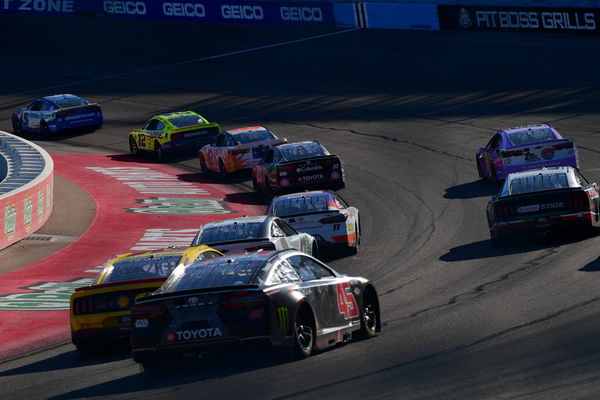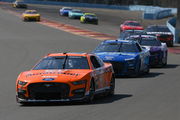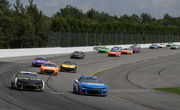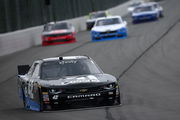
USA Today via Reuters
Nov 5, 2023; Avondale, Arizona, USA; NASCAR Cup Series driver Kyle Larson (5) leads driver Ryan Blaney (12) and a group during the Cup Series Championship race at Phoenix Raceway. Mandatory Credit: Gary A. Vasquez-USA TODAY Sports

USA Today via Reuters
Nov 5, 2023; Avondale, Arizona, USA; NASCAR Cup Series driver Kyle Larson (5) leads driver Ryan Blaney (12) and a group during the Cup Series Championship race at Phoenix Raceway. Mandatory Credit: Gary A. Vasquez-USA TODAY Sports
Over the years, NASCAR has faced plenty of obstacles to ensure smooth functioning. While some of them have been unavoidable, not many came close to the crisis in 1973. The United States encountered a daunting crisis when the Organization of Petroleum Exporting Countries (OPEC) decided to stop exporting oil to them.
While it was an issue of massive scale, the American government was called upon to take stringent action. With the shortage in fuel supply, NASCAR faced the challenge of cutting the normal lengths of specific races.
ADVERTISEMENT
Article continues below this ad
The OPEC Oil Embargo forced NASCAR to perform a stroke of genius in 1974
While the OPEC oil crisis started in 1973, it only got worse in 1974. With normal racing at stake, NASCAR met with officials of the NHRA, IMSA, USAC, and SCCA to ensure racing is not hampered significantly. Having said that, the task was not easy with Bill France Sr stepping down as Executive Director in 1972. The pressure built on his replacement, John Copper, to take some prompt action. The then-President Richard Nixon took several strict calls, including shutting down gas stations in the country from 9 p.m. Saturday to midnight Sunday.
4/ Triggered by the oil crisis of 1973, when an OPEC oil embargo sent oil prices skyrocketing, the US experienced a recession with rising prices.
In the US, inflation doubled in 1973 and hit 11% in 1974. GDP fell for 5 consecutive quarters and unemployment hit 9% in 1975.
— Sahil Bloom (@SahilBloom) September 2, 2020
That resulted in quite a few races being shifted to Saturday from Sunday. At the same time, NASCAR was compelled to think outside the box. As a result, they came up with a study. The research showed the sport ended in the seventh spot in fuel consumption.
Surprisingly, vacation travel, airline travel, movie attendees, football fan attendance, basketball, and horse racing consumed more fuel. With this in mind, NASCAR proactively reduced the length of plenty of races by 10% to save fuel. At the same time, other leagues and entities faced a reduction in fuel consumption of 20 to 25%.
READ MORE – NASCAR’s Highly Speculated Partnership With Amazon Divides Stock Car Community
While it was a difficult task for others, NASCAR ended up saving 30% in fuel consumption in 1974 as compared to 1973. Indeed, it was a significant achievement before normal racing began in 1975. During all this, one of the iconic changes that took place was in the Great American Race. The Daytona 500 turned into the Daytona 450.
Trending
Year after the oil crisis, Richard Petty made history at Daytona International Speedway
Due to NASCAR’s decision to cut down the length of various races by 10%, the 16 running of the Daytona 500 took a hit. Instead of the 500-mile race, the length was trimmed to 450 miles, with 180 laps deciding the final outcome.
ADVERTISEMENT
Article continues below this ad
Surprisingly, the race witnessed 59 official lead changes among 15 drivers, with Richard Petty eventually winning the improvised Daytona 500, i.e., Daytona 450. In the process, Petty beat the likes of Cale Yarborough, Ramo Stott, and Coo Coo Marlin.
The King leading the way in the 1974 #DAYTONA500! #tbt pic.twitter.com/1d4hQ4MciN
— Daytona International Speedway (@DAYTONA) March 22, 2018
ADVERTISEMENT
Article continues below this ad
Coincidentally, the seven-time NASCAR Cup Series champion led 74 laps in the 1974 Daytona 500. While it was a special race because of a number of reasons, Petty made the best use of the conditions. All in all, NASCAR did a fine job handling a threatening crisis without significantly disturbing the flow of racing.
WATCH THIS STORY: NASCAR’s Historic Track on the Brink of Extinction
ADVERTISEMENT
ADVERTISEMENT
ADVERTISEMENT
ADVERTISEMENT






